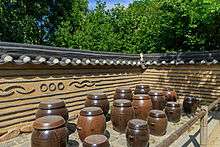Jangdokdae
| Jangdokdae | |
|
Jangdokdae at Gyeongbok palace in Seoul | |
| Korean name | |
|---|---|
| Hangul | 장독대 |
| Revised Romanization | jangdokdae |

Jangdokdae (Hangul:장독대) or Jangttokttae is an outside space, most frequently a terrace, where a series of jars are gathered.
The jars are a subkind of Jangdok (or Onggi), a Korean ethnic earthenware. They are used to ferment or simply store comestible goods, typically Kimchi, soybeans, bean and red pepper paste[1] or grains.
Jangdok (Hangul:장독) means "a (big) jar" and dae (Hangul:대) means "place", "support"... so jangdokdae (Hangul:장독대) means "place for jangdok(s)". The jars are called hangari (Hangul:항아리)[2] or onggi (Hangul:옹기).[3]
This place is commonly found directly near traditional Korean houses, more precisely near the kitchen. Sunshine and ventilation are key aspects in the location choice, so that foods can be preserved and kept fresh.[4] Well-preserved ingredients may stay for several years in the jars.
See also
| Wikimedia Commons has media related to Jangdokdae. |
References
- ↑ Korean Culture and Information Service (KOCIS). "The Wonders of the jangdokdae". Korea.net. Retrieved 10 December 2014.
- ↑ "Rice Cake and Traditional Kitchen Utensils Museum". My Korean Kitchen. Retrieved 10 December 2014.
- ↑ "Korea Information". Asia-planet.net. Retrieved 10 December 2014.
- ↑ "Korea Information". Asia-planet.net. Retrieved 10 December 2014.